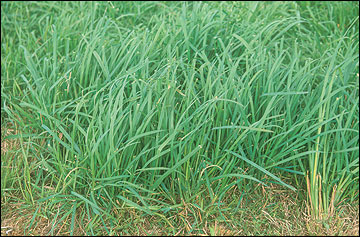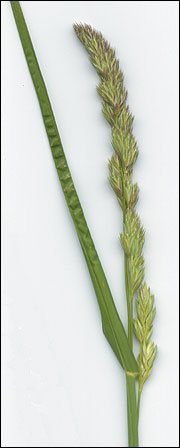Orchardgrass (Dactylis glomerata L.)
Cool-season grasses
Orchardgrass is a popular grass for pasture, green chop, silage and hay throughout the central part of the eastern United States. The high rainfall, moderate winters and warm summers of southern Missouri make that region an optimal orchardgrass habitat. Under such conditions, orchardgrass both grows and tillers rapidly, which makes it especially useful in early spring pastures. Forage yields of 7,000 to 10,000 lb/acre are not uncommon under good management. Orchardgrass is more drought-tolerant than timothy or Kentucky bluegrass but is not as drought-tolerant as smooth bromegrass or endophyte-infected tall fescue. Orchardgrass does not persist as well as other cool-season grass species because it is susceptible to overgrazing, winter kill and leaf rust. Orchardgrass matures earlier than most other cool-season grasses, which makes early grazing or harvesting a must if high-quality feed is to be obtained. Choosing a variety that matures late can help increase forage quality. It is considered more wildlife friendly than tall fescue.
 Orchardgrass
Orchardgrass
 Yield distribution of orchardgrass in Missouriwith differed grazing.
Yield distribution of orchardgrass in Missouriwith differed grazing.
- Origin: Europe and North Africa
- Adaptation to Missouri: Statewide
- Growth habit: Perennial bunchgrass.
- Blade: Folded in bud, cross section V-shaped at base, sharply keeled, taper to an acute point, margins smooth to scabrous.
- Sheath: Smooth, open, distinctively flattened and keeled.
- Ligule: Truncate, membranous, 1/10 to 1/3 inch long.
- Auricles: Absent.
- Seed head: Stiff, mostly compact panicle with lower branches longer than those at top.
- Fertilization: 40 to 60 lb N/acre after first grazing or harvest in spring; follow with another 40 lb N/acre after second grazing if conditions permit. Also, apply 40 to 60 lb N/acre mid-August for fall pasture. Phosphorus and potassium to soil test.
- Timing of production: 60 percent of growth before June 15.
- When to begin grazing: When the grass reaches 6 to 8 inches in height.
- When to cut for hay: Early heading stage, typically in late April or early May.
- Lowest cutting or grazing height: 4 inches
- Fall management: Grazing possible in September and October; leave a 6-inch stubble for winter.

